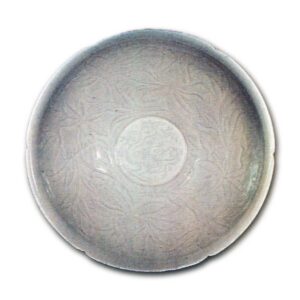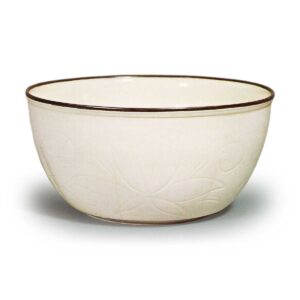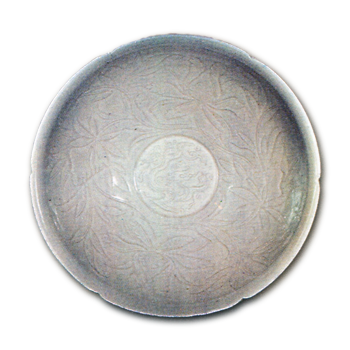

A famous kiln of the Song dynasty in China. It is said to have been located in Ding County, Hebei Province. It is said to have been located in Ding County, Hebei Province, and was known for its white porcelain wares, which were the most abundant and beautiful in the world. The body was thinly made of fine white clay, and patterns of flowers, lotus ponds, water fowls, etc. were carved or molded into the body. Bowls, plates, and bowls were the most common types of vessels, while washing and small water jars were somewhat rare. The glaze is a thin ivory color and sometimes shows yellowish tints, which are called “tear marks” by the general public. The thin glaze of these pots and jars is usually fired under high heat for fear that it would sag under high temperatures. The mouth rim is glazed with gold, silver, copper, or other covering. There are also shi-tei, kuro-tei, and beni-tei. The type called sumi-tei is probably a type of kuro-tei. There are also white porcelains copied from Ding kilns, called “earthenware” and “powdered” porcelains. The Jingdezhen wares produced after the Nandu in the Song Dynasty are called Nanding, while those produced before that time are called Beiding. The Ding kiln was the most prosperous kiln before Jingdezhen became prosperous, and many kilns were made in imitation of the Ding kiln. In the “Geko kyoron” (Ancient Essays on the Art of War), it is said that “the most valuable ancient Ding ware is that which is fine, white, and rich in color, while that which is poor in texture and yellow in color, and that which has tear marks on the outside is true, the best is that of painting and flowers, the best is that which is plain, the second best is that of embroidery, the kiln between Xuanhe and Chenghe in the Song Dynasty is the most favorable, but those from the Chengtai are not available, the color is purple and the color is black, like lacquer. In the “Ruqing Daily”, it is written, “The color is similar to that of the elephant kiln, and those with bamboo thread prints are called the Bei Ding kiln, while the Nan Ding kiln is the one with flowers, which appeared after Nandu”. There are two types of Jogama: kouson and convex flower. White is the correct color, and some are white-boned and water-soaked like tear marks. The “Ceramic Commentary” goes on to quote from the above notes, “By way of comparison, Hokucho is the most prized of the Ding ware, and the kilns between Seiwa and Seonwa are the most favorable, but as the poem by Dongpo Tongpo in his Trial Yuan Sencha says, Dingju porcelains made with red jade are not from before Seiwa, nor do they necessarily appear after Nandu, as the term “huajitsu” means “floral porcelain. There was also a goldsmith of the Yuan dynasty, Peng Gyunpo, who made folding and waist-like shapes using set vessels, which were very symmetrical and symmetrical. The ancient treatise on the Case and Ancient Essays says that the clay and pig iron are similar to Tei ware, but lack moisture and are extremely brittle compared to blue ware, and the Natural History Review says that new Tei ware, such as Wen Wang’s Ding ware and the wares with animal faces and fangs, are not less than Tei ware, and should thus be considered as true and undisturbed. In the “Jingdezhen Ceramic Record,” it is written, “The Ding kiln was fired in the Song Dynasty and came directly from Dingzhou, and there are Nanjing ware and Beijing ware. The clay is fine and thin, and there are various types of flowers, such as convex flowers, painted flowers, ink flowers, and embroidery, They are white in color and rich in nutrients, and are called “kojei,” or “white-tei,” or “white-tei. Dongpo’s poem on the tea ceremony at Tianyuan says that Dingzhou porcelain is known as “red jade,” and Chiangji says that Jingdezhen ceramics are known as “red jade,” and if you look at true red porcelain, you will see that they are both red, and that they can compete with each other. According to Tang Four Novels, the best ancient vessels were made in the kilns during the Seiwa and Xuanwa periods, and they are colored with bamboo thread prints. The purple is the color purple and the black is the color lacquer, and it is not to be valued highly. In Yunryusai Seiryu (飲流斎説瓷), it is written, “The one made in Jikkaku Dingzhou is called Beiding, which was first constructed in the Song Dynasty. The flowers come in many forms, such as peonies, cherries, flying phoenixes, and vases, and the source of their beauty is found in the Qin mirror, making one wonder how many of them were made by humans. The body of Nandei is extremely fine and the color is extremely white, and the glaze is white glass. The glaze of genuine kojei is shiny and moist, the same as that of ivory, and there are many willow-patterned openings in the glaze, not unlike those of counterfeit pieces, while the glaze of counterfeit pieces is sometimes thick, sometimes thick and dry, sometimes thick and transparent, sometimes thick and pale, not unlike that of genuine pieces, and there is no one type of kojei, the body being thick or thin, the color being the most precious with flashing red and the color flashing yellow. The color is not uniform, and the body can be thick or thin, with the color of flash red being the most prized, followed by flash yellow. There is a theory that Ding ware red porcelain is Tianmu, and there are also theories to the contrary. For Japanese literature on Dingyosi, see “Yashu,” No. 6, “Shina Ceramic Artifacts,” “Shina Ancient Ceramics,” “Shina Pottery,” and “Ceramics,” Vol. 7, No. 3.



